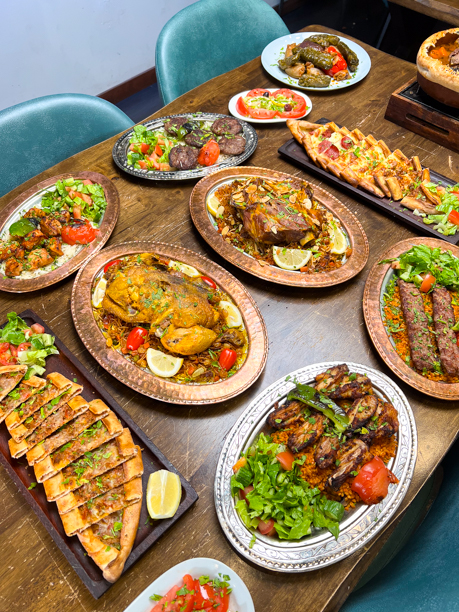Lebanese and Turkish food are renowned for their exquisite flavours and unique culinary traditions. In this blog post, we will look into the delightful world of Middle Eastern cuisine, explicitly comparing the distinct characteristics of Lebanese and Turkish dishes. From the use of fresh ingredients to the cooking techniques employed, each cuisine offers a diverse palate of flavours that captivate food enthusiasts worldwide.
The vibrant colours, aromatic spices, and intricate flavour profiles of Lebanese and Turkish cuisines paint a culinary canvas that reflects the rich tapestry of cultures and histories woven throughout the Middle East. Exploring the bustling markets of Beirut and the bustling streets of Istanbul, one can witness the culinary craftsmanship and passion that infuse every dish with a story of tradition and innovation.
Whether savoring a fragrant plate of kibbeh nayyeh in Lebanon or indulging in a decadent slice of baklava in Turkey, the culinary journey through these two gastronomic powerhouses is a sensory experience that lingers long after the last bite. Join us as we unravel the secrets of Lebanese and Turkish cuisine, celebrating the artistry, diversity, and culinary heritage that continue to inspire and delight food lovers worldwide.
Lebanese Cuisine
Lebanese cuisine is not just about food; it reflects Lebanon’s rich history, cultural diversity, and geographical location. Its roots trace back to ancient times, influenced by civilizations such as the Phoenicians, Romans, Ottomans, and French.
This historical tapestry is evident in Lebanese dishes, which often feature a harmonious blend of flavours and ingredients. For example, tabbouleh, a quintessential Lebanese salad, showcases the freshness of parsley, mint, and tomatoes, reflecting Lebanon’s agricultural abundance and Mediterranean climate. Similarly, dishes like kibbeh, made from ground meat, bulgur wheat, and spices, highlight the Levantine tradition of using simple yet flavourful ingredients.
Moreover, Lebanese cuisine’s emphasis on mezze—a selection of small dishes served as appetizers—encourages communal dining and embodies the Lebanese value of hospitality. Mezze dishes like hummus, baba ghanoush, and falafel offer a mosaic of flavours and textures, inviting diners to savor each bite while engaging in lively conversation. Overall, Lebanese cuisine is not just about sustenance; it celebrates life, bringing people together through the shared experience of food, flavours, and culture.
Turkish Cuisine
Turkish cuisine proves the country’s rich cultural heritage and position as a bridge between East and West. Influenced by the Ottoman Empire and the diverse cultures along the Silk Road, Turkish cuisine is a culinary mosaic reflecting centuries of culinary exchange and innovation.
One of the mirroring features of Turkish cuisine is its use of spices, herbs, and aromatics, which infuse dishes with layers of flavor and complexity. For instance, dishes like kebabs and pilafs showcase the mastery of Turkish chefs in balancing various spices and ingredients to create harmonious flavor profiles.
Additionally, Turkish cuisine‘s love affair with sweets is evident in its decadent desserts, such as baklava, künefe, and Turkish delight, which combine delicate pastry, nuts, and syrup to create indulgent treats for royalty. Moreover, Turkish cuisine‘s emphasis on hospitality is reflected in its tradition of çay (tea) and Turkish coffee, which are not just beverages but symbols of friendship, conversation, and social connection.
Whether enjoying a leisurely breakfast spread of simit (sesame bread) and olives or indulging in a lavish feast of mezes and grilled meats, Turkish cuisine invites diners on a sensory journey that delights the palate and nourishes the soul.
Distinctions Between Lebanese And Turkish Cuisine
While Lebanese and Turkish cuisines share some similarities, such as their use of fresh ingredients and grilling techniques, distinct differences set them apart. Lebanese cuisine tends to be lighter and fresher, emphasizing salads, herbs, and citrus flavours.
In contrast, Turkish cuisine leans towards heartier dishes, emphasizing meat, dairy, and spices. For example, while both cuisines enjoy variations of kebabs, Lebanese kebabs often feature lighter marinades. They are served with salads and dips, whereas Turkish kebabs may be more robustly spiced and accompanied by rice or bread.
Similarly, Lebanese cuisine uses sumac, pomegranate molasses, and za’atar. It imparts unique flavours that distinguish it from Turkish cuisine, which may rely more on spices like cumin, paprika, and mint. While both cuisines share a common culinary heritage, their distinct flavours, ingredients, and preparations reflect the diverse traditional influences that have shaped them.
Culinary Influences And Crossroads
The culinary landscapes of Lebanon and Turkey are a testament to the countries’ rich histories as cultural crossroads. Lebanon’s location at the intersection of the Mediterranean, coupled with its history of colonization and trade, has led to a delicious melting pot that draws influences from the Levant, Europe, and beyond.
Turkish cuisine, similarly, reflects the country’s position as a bridge between Europe and Asia, with influences from Central Asia, the Middle East, and the Balkans. Trade paths such as the Silk Road were vital in exchanging ingredients, spices, and cooking techniques, enriching Lebanese and Turkish cuisines with diverse flavours and traditions.
Moreover, historical events such as the Ottoman Empire’s expansion into the Levant and the Arab diaspora have further contributed to the culinary interchange between Lebanon and Turkey, resulting in shared dishes, ingredients, and cooking methods that transcend national borders. Today, the culinary landscapes of Lebanon and Turkey continue to change, with chefs and home cooks celebrating the countries’ shared heritage while embracing innovation and experimentation in the kitchen.
Modern Culinary Trends And Innovations
In recent years, Lebanese and Turkish cuisines have experienced a culinary renaissance, with chefs and home cooks rediscovering traditional recipes and ingredients while incorporating modern twists and techniques.
This resurgence of interest in culinary heritage reflects a growing appreciation for authenticity, sustainability, and seasonality in food. For example, Lebanese chefs may reinterpret classic dishes like fattoush or manakish (Lebanese flatbread) using locally sourced, organic ingredients. In contrast, Turkish chefs may experiment with fusion cuisine, combining traditional Turkish flavors with global culinary influences.
Moreover, the jump in social media and food tourism has provided platforms for showcasing Lebanon and Turkey’s rich culinary traditions worldwide, sparking interest in exploring the countries’ gastronomic delights firsthand. Whether it’s a pop-up restaurant serving modern Lebanese street food or a Turkish chef reinventing traditional mezes with avant-garde presentations, the culinary landscapes of Lebanon and Turkey continue to evolve, driven by a passion for preserving heritage while embracing innovation in the ever-changing world of gastronomy.
Which Is Better?
Whether cuisine is better—Lebanese or Turkish—is ultimately subjective and depends on individual preferences, dietary restrictions, and cultural experiences. Lebanese and Turkish cuisines offer rich flavours, textures, and aromas that celebrate the countries’ culinary heritage and cultural diversity. Lebanese cuisine emphasizes fresh ingredients, vibrant salads, and light, herb-infused dishes, making it a popular choice for those seeking a healthy and refreshing dining experience. On the other hand, Turkish cuisine‘s rich and robust flavours, extensive use of spices, and indulgent desserts appeal to those with a penchant for savoury delights and sweet treats. Ultimately, whether you’re indulging in a mezze feast in Beirut or savoring a kebab in Istanbul, both Lebanese and Turkish cuisines offer a delightful culinary journey that honors the diversity and richness of Middle Eastern flavours, leaving diners with a memorable gastronomic experience that lingers long after the last bite.
Experience The Finest Middle Eastern Cuisine At Finjan
At Finjan, we invite you to enter on a delicious culinary journey through the vibrant and diverse flavours of the Middle East. Nestled in the heart of Oakville city, our restaurant is a retreat for food enthusiasts seeking an authentic taste of the Middle East. From the moment you step through our doors, you’ll be greeted by the delicious aromas of freshly baked bread, sizzling meats, and fragrant spices, setting the stage for an unforgettable dining experience. So join us for an epicurean voyage that will delight your palate and take you to the vibrant streets of the Middle East!
Conclusion
In conclusion, the culinary realms of Lebanese and Turkish cuisine offer a vibrant tapestry of flavours, traditions, and cultural influences. Exploring the differences between Lebanese and Turkish food reveals a rich taste heritage that captivates food lovers globally. From Beirut’s markets to Istanbul’s streets, each dish tells a story blending tradition with innovation.

